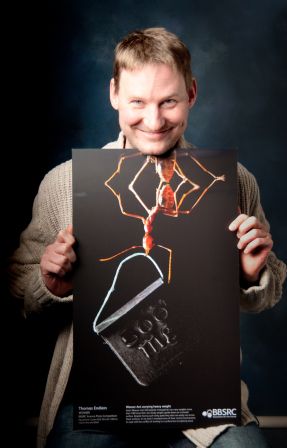Glasgow welcomes prize winning science photographer
Published: 25 February 2010
Dr Thomas Endlein joins Faculty of Biomedical and Life Sciences to study tree frogs and their sticky feet
An image of a tiny ant carrying 100 times its own body weight - while hanging upside down from a glass-like surface - has won first prize in the inaugural Biotechnology and Biological Sciences Research Council (BBSRC) science photo competition.
The photograph was taken by Dr Thomas Endlein, now at Glasgow, while he was with the Department of Zoology at Cambridge University.
During his time there, he and members of the Zoology team investigated the extraordinarily sticky feet of ants and other insects.
The image shows an asian weaver ant, upside down on a smooth surface, carrying a 500mg weight in its jaws. Weaver ants use their feet and their legs to achieve their sticky feats.
The win awarded Dr Endlein, who has now joined Dr Jon Barnes’ team in Molecular and Cell Biology in the Faculty of Biomedical and Life Sciences, £700-worth of vouchers for photographic equipment.
According to the BBSRC, the photograph won first prize, because as well as being a beautiful image, it managed to convey complex science.
Dr Endelin said he is delighted with his move to Glasgow and is looking forward to a new field of research which will involve studying the sticky feet of a particular type of tropical frog.
Of his photograph he said; "Ants can change the size and shape of the pads on their feet depending on the load they are carrying. If they have to carry heavy loads they increase the contact area, and when they need to run they decrease it. The ants' legs also play a part in the insects' stickiness by making clever use of what scientists call "peeling forces".
"If you think about peeling off sticky tape from a surface, it's easiest when you peel at a steep, rather than a shallow, angle. Ants use the same mechanism: when they want to stick, they keep their legs at a shallow angle relative to the surface, and when they want to release their legs they increase this angle and peel off easily."
Dr Endelin also found that the pads on ants' feet are self-cleaning and can stick to almost any type of surface - no man-made glue or adhesive system can match this.
For more information on the BBSRC photography competition please see:
http://www.bbsrc.ac.uk/science/our-science-explained/1002-the-art-of-science.aspx
For more media information please contact Eleanor Cowie, Media Relations Officer on 0141 330 3683 or e.cowie@admin.gla.ac.uk
First published: 25 February 2010
<< February

